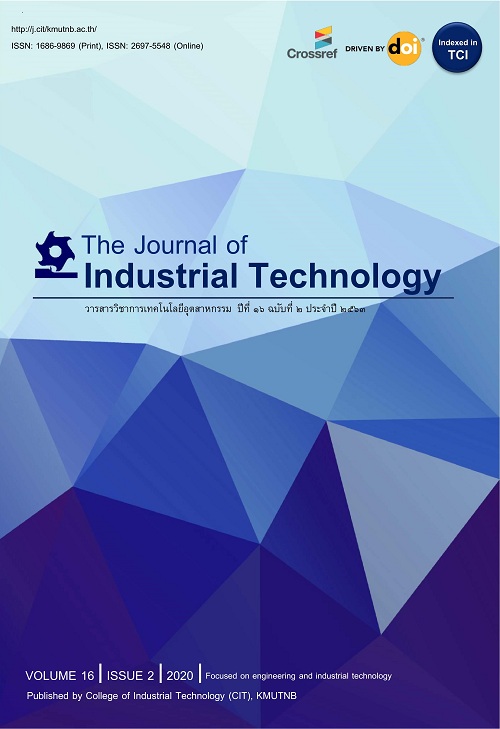Effect of Crosslinking Agent and Blowing Agent on the Properties of Natural rubber: Morphology and Mechanical Properties - Before and After Fuel Swelling
Abstract
งานวิจัยนี้ศึกษาเกี่ยวกับผลของการเติมสารเชื่อมโยงโมเลกุล และสารทำให้เกิดฟองในปริมาณต่าง ๆ ที่มีต่อสัณฐานวิทยาและสมบัติเชิงกลทั้งก่อนและหลังการบวมตัว ของยางธรรมชาติ เพื่อทำเป็นชั้นยางกันรั่วของถังน้ำมันเชื้อเพลิงชนิดกันรั่วได้ด้วยตัวเอง โดยนำยางมาผสมกับสารเชื่อมโยงโมเลกุล (0.5 และ 1.5 phr) และ สารทำให้เกิดฟอง (0 4 8 และ 12 phr) ที่สัดส่วนต่าง ๆ ด้วยเครื่องผสมยางแบบสองลูกกลิ้ง นำยางที่ได้มาหาระยะเวลาที่ยางใช้ในการคงรูป (tc90) ด้วยเครื่องรีโอมิเตอร์แบบจานแกว่ง จากนั้นขึ้นรูปชิ้นงานยางด้วยเครื่อง กดอัดด้วยความร้อน นำชิ้นงานที่ได้มาหาปริมาณรูพรุนและทดสอบสมบัติเชิงกล (ได้แก่ ค่าการทนต่อแรงดึงสูงสุด ค่าการยืดตัว ณ จุดขาด และค่ามอดุลัส) ทั้งก่อนและหลังการบวมตัว ด้วยกล้องจุลทรรศน์และเครื่องทดสอบแรงดึงยืดอเนกประสงค์ ตามลำดับ จากการทดลองสรุปได้ว่าการเติมสารเชื่อมโยงโมเลกุลและสารทำให้เกิดฟอง ส่งผลต่อสัณฐานวิทยาและสมบัติเชิงกลทั้งก่อนและหลังการบวมตัวในน้ำมันเชื้อเพลิง จากผลการทดลองสรุปได้ว่ายางสูตร NR2 ที่เติมสารเชื่อมโยงโมเลกุลและสารทำให้เกิดฟองที่ปริมาณ 1.5 และ 4 phr ตามลำดับ เป็นยางที่เหมาะสมที่สุดสำหรับทำเป็นชั้นยางกันรั่วดังกล่าว เพราะมีสัดส่วนของเนื้อยางและรูพรุนที่เหมาะสม ทำให้มีอัตราการบวมตัวเร็วสุด และมีความแข็งแรงสูงสุดทั้งก่อนและหลังการบวมตัว
This research work studies the effect of crosslinking agent and blowing agent at various concentrations, on morphology and mechanical properties, as before and after fuel swelling, of the natural rubbers which applied as the self-sealing layer of the fuel tank. The rubbers were blended with the crosslinking agent (0.5 and 1.5 phr), and the blowing agent (0, 4, 8 and 12 phr) at various concentrations, by using a two-roll mill machine. The curing time (tc90) of each rubber was measured by using an oscillating disk rheometer. The rubbers were fabricated by using a hot-press compression molding machine. Then, the rubbers were measured the porous content and the mechanical properties (such as ultimate tensile strength, elongation at break and modulus), as before and after fuel swelling, by using an optical microscope and a universal testing machine, respectively. It was found that the crosslinking agent and the blowing agent affected to morphology and mechanical properties of the rubbers, as before and after fuel swelling. From these results, it can be concluded that the best formula that proper to use as self-sealing materials was NR2, which was the rubber that blended with the crosslinking agent and the blowing agent at 1.5 and 4 phr, respectively. Because this rubber has a proper ratio of the rubber matrix and the porous, as a result, it has the highest rate of swelling and strength, as before and after fuel swelling.
Keywords
[1] T.A. Underwood, W.S. Wickersham Jr. and R.W. Sutton, Self-sealing fuel cell wall, United State Patent, US3509016DA.
[2] P.J. Dasher, Self-sealing fuel tank, United State Patent, US41778741A.
[3] T.S. Ohnstad, R.A. Monk, Sealing-reaction, layer-effective, stealth liner for synthetic fuel container, United States Patent Application, US2009/0050629 A1.
[4] L. Spenadel, Synthetic rubber for self-sealing fuel tanks, Applied Science Research Laboratory, 1959, 51(8), 935-936.
[5] www.atlltd.com/industries/defence-security/self-sealing-tanks. (Accessed on 14 February 2020)
[6] R.A.Crawford, Self-sealing fuel tank construction, United State Patent, US47784843A.
[7] www.hutchinsoninc.com/protected-fuel-tank/. (Accessed on 11 January 2020)
[8] C.C. Chin, N.D.L. Musbah, I. Abdullah and A.M. Lazim, Characterization and evaluation of prudent liquid natural rubber-based foam for oil spill control application, Arabian Journal for Science and Engineering, 2018, 43, 6097–6108.
[9] www.dsiac.org/articles/advances-in-self-sealing-fuel-tank-technology/. (Accessed on 25 January 2020)
[10] M. Barlkani and C. Hepburn, Determination of crosslink density by swelling in the castable polyurethane elastomer based on 1/4-cyclohexane diisocyanate and para-phenylene diisocyanate. Iranian Journal of Polymer Science and Technology, 1992, 1(1), 1–5.
[11] A. Khalaf, A. Yehia, M. Ismail and H. El-Sabbagh, High performance oil resistant rubber, Open Journal of Organic Polymer Materials, 2012, 2(04), 88-93.
[12] R. Maharsia, N. Gupta and H.D. Jerro, Investigation of flexural strength properties of rubber and nanoclay reinforced hybrid syntactic foams, Materials Science and Engineering: A, 2006, 417(1), 249-258.
[13] O. Okay, S. Durmaz and B. Erman, Solution cross-linked poly (isobutylene) gels: synthesis and swelling behavior, Macromolecules, 2000, 33(13), 4822-4827.
[14] L.J. Gibson, Biomechanics of cellular solids, Journal of Biomechanics, 2005, 38(3), 377-399.
[15] M. Krumova, D. Lopez, R. Benavente, C. Mijangos and J. Perena, Effect of crosslinking on the mechanical and thermal properties of poly (vinyl alcohol). Polymer, 2000, 41(26), 9265-9272.
[16] J. He, Z. Zhang, H. Kristiansen, K. Redford, G. Fonnum and G. Modahl, Crosslinking effect on the deformation and fracture of monodisperse polystyrene-co-divinylbenzene particles. Express Polymer Letters, 2013, 7(4), 365-374.
[17] G.R. Hamed, Materials and compounds, Engineering with Rubber: How to Design Rubber Components, 3rd Ed., Hanser Books, OH, USA, 1992.
[18] J. Bras, M.L. Hassan, C. Bruzesse, E.A. Hassan, N.A. El-Wakil and A. Dufresne, Mechanical, barrier, and biodegradability properties of bagasse cellulose whiskers reinforced natural rubber nanocomposites, Industrial Crops and Products, 2010, 32(3), 627-633.
[19] H. Ismail, H.D. Rozman, R.M. Jaffri and Z.A.M. Ishak, Oil palm wood flour reinforced epoxidized natural rubber composites: the effect of filler content and size. European Polymer Journal, 1997, 33(10), 1627-1632.
[20] D. Ceylan, S. Dogu, B. Karacik, S. D. Yakan, O. S. Okay and O. Okay, Evaluation of butyl rubber as sorbent material for the removal of oil and polycyclic aromatic hydrocarbons from seawater, Environmental Science and Technology, 2009, 43(10), 3846-3852.
[21] H. Li, L. Liu, F. Yang, Hydrophobic modification of polyurethane foam for oil spill cleanup. Marine Pollution Bulletin, 2012, 64(8), 1648-1653.
DOI: 10.14416/j.ind.tech.2021.12.003
Refbacks
- There are currently no refbacks.






